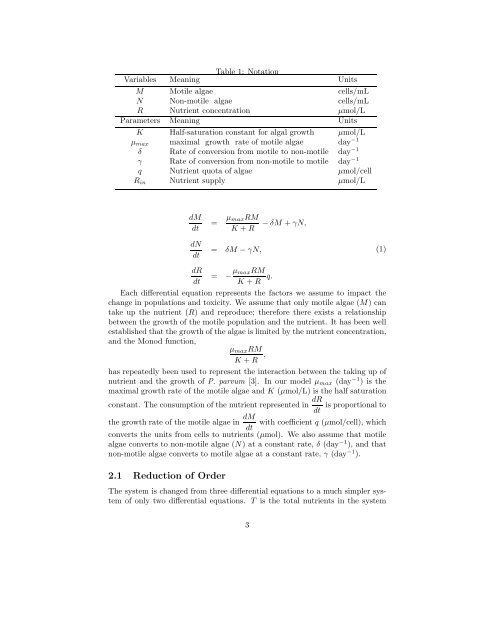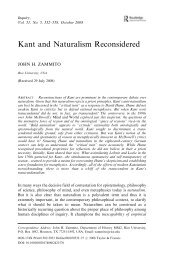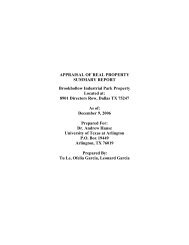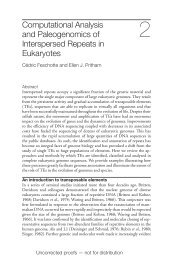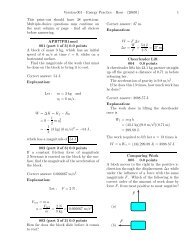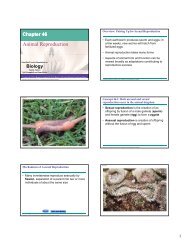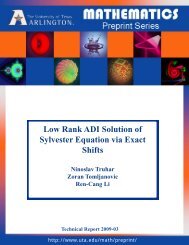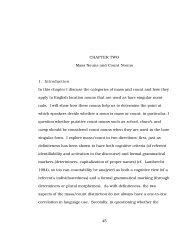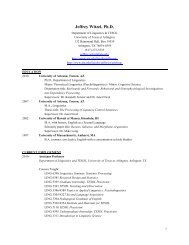Resting Stages and the Population Dynamics of Harmful Algae in ...
Resting Stages and the Population Dynamics of Harmful Algae in ...
Resting Stages and the Population Dynamics of Harmful Algae in ...
- No tags were found...
Create successful ePaper yourself
Turn your PDF publications into a flip-book with our unique Google optimized e-Paper software.
Table 1: NotationVariables Mean<strong>in</strong>g UnitsM Motile algae cells/mLN Non-motile algae cells/mLR Nutrient concentration µmol/LParameters Mean<strong>in</strong>gUnitsK Half-saturation constant for algal growth µmol/Lµ max maximal growth rate <strong>of</strong> motile algae day −1δ Rate <strong>of</strong> conversion from motile to non-motile day −1γ Rate <strong>of</strong> conversion from non-motile to motile day −1q Nutrient quota <strong>of</strong> algae µmol/cellR <strong>in</strong> Nutrient supply µmol/LdMdt= µ maxRMK +R−δM +γN,dNdtdRdt= δM −γN,= − µ maxRMK +R q. (1)Each differential equation represents <strong>the</strong> factors we assume to impact <strong>the</strong>change <strong>in</strong> populations <strong>and</strong> toxicity. We assume that only motile algae (M) cantake up <strong>the</strong> nutrient (R) <strong>and</strong> reproduce; <strong>the</strong>refore <strong>the</strong>re exists a relationshipbetween <strong>the</strong> growth <strong>of</strong> <strong>the</strong> motile population <strong>and</strong> <strong>the</strong> nutrient. It has been wellestablished that <strong>the</strong> growth<strong>of</strong> <strong>the</strong> algae is limited by <strong>the</strong> nutrient concentration,<strong>and</strong> <strong>the</strong> Monod function,µ max RMK +R ,has repeatedly been used to represent <strong>the</strong> <strong>in</strong>teraction between <strong>the</strong> tak<strong>in</strong>g up <strong>of</strong>nutrient <strong>and</strong> <strong>the</strong> growth <strong>of</strong> P. parvum [3]. In our model µ max (day −1 ) is <strong>the</strong>maximal growth rate <strong>of</strong> <strong>the</strong> motile algae <strong>and</strong> K (µmol/L) is <strong>the</strong> half saturationconstant. The consumption <strong>of</strong> <strong>the</strong> nutrient represented <strong>in</strong> dR is proportional todt<strong>the</strong> growth rate <strong>of</strong> <strong>the</strong> motile algae <strong>in</strong> dM with coefficient q (µmol/cell), whichdtconverts <strong>the</strong> units from cells to nutrients (µmol). We also assume that motilealgae converts to non-motile algae (N) at a constant rate, δ (day −1 ), <strong>and</strong> thatnon-motile algae converts to motile algae at a constant rate, γ (day −1 ).2.1 Reduction <strong>of</strong> OrderThe system is changed from three differential equations to a much simpler system<strong>of</strong> only two differential equations. T is <strong>the</strong> total nutrients <strong>in</strong> <strong>the</strong> system3


